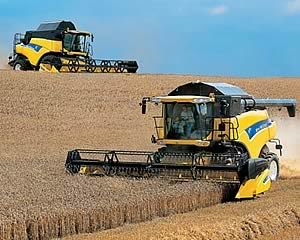 |
|||||||||
|
|||||||||||||||||||
|
|
Rhizobacteria Project Shows Major UK Wheat Productivity Gains 2010-05-17 Leading researchers involved in a four year, nine nation EU-funded project have successfully harnessed plant growth promoting root bacteria to improve the yield of top performing wheat varieties by the best part of 0.75 t/ha under UK conditions.
This promising indication of the value of rhizobacterial inoculation in boosting northern hemisphere crop productivity provides UK growers with the possibility of replacing a good 50 kg/ha of applied nitrogen in their wheat production to markedly reduce both fertiliser bills and carbon footprints. “Our findings need to be validated over a wider range of conditions and environments before we can reliably quantify the value of any commercial savings, “ stressed RHIBAC (Rhizobacteria for Reduced Inputs in Wheat) project leader, Professor Nicolaus von Wirén at his team’s latest annual meeting at Masstock’s Throws Farm Development Centre which has coordinated the main UK field trial work. “We are, however, excited about the progress we have made over the past four years in bringing the huge promise of plant growth promoting rhizobacteria (PGPR) closer to commercial reality for European cereal growers. In particular, we have developed a far greater understanding of the way these valuable soil microbes work and how they can best be utilized in modern production systems. “Researchers investigating the application of PGPR in key arable crops like wheat and maize for over 30 years have been plagued by low success rates and reproducibility,” he pointed out. “The solid science our researchers have been engaged upon in this EU Framework 6 project and its MicroNfix predecessor is far from glamorous. But it has enabled us to make what could prove to be a decisive breakthrough in helping modern farming meet its over-riding need to produce more from less.” Unlike the long-appreciated value of rhizobia in legumes, RHIBAC microbiologist, Instead, they profilerate in, on and around the roots and have a number of different physiological effects. These include excreting ammonia, increasing the bio-availability of nutrients like phosphate, suppressing soil-borne pests, and producing auxin-like and other plant growth promoting chemicals. “With our collaborators across Europe, South America, Turkey and Israel, we have been working with a number of soil micro-organisms showing positive plant growth promoting effects,” he explained. “In addition to nitrogen fixation, our main focus has been on those involved in phosphate solubilisation and phyto-hormone production. “As well as recording major effects on root hair development and plant growth from natural populations, our microbiological team has been exploring the genetic improvement of promising strains, ways of improving the efficiency with which they colonise root systems, and mechanisms for producing inocula that deliver them with the greatest efficiency in modern arable regimes.” The extent to which these and other elements of RHIBAC’s pioneering work is proving valuable is clearly demonstrated in the results Colin Lloyd and his Masstock colleagues have recorded over the past year in the project’s fully replicated field trials at Throws Farm in Essex and Marlborough in Wiltshire. These have involved four modern UK winter wheat varieties – Robigus, Viscount, Alchemy and Oakley – produced with different levels of nitrogen fertilisation and four of the most promising RHIBAC strains incorporated with the seed at sowing. Averaged across all four varieties, yield improvements of 0.73 t/ha (+8%) and 0.70 t/ha (+6%) respectively were recorded in the two trials when selected rhizobacteria were added to a standard150 kg N/ha fertiliser regime. And similar improvements were apparent with each variety. “Comparing these results with the six different nitrogen-only treatment levels we used as controls shows bacterial inoculation was worth a statistically significant 50-100 kg N/ha,” observed Colin Lloyd. “Interestingly, we recorded no differences in crop height, ear number or thousand grain weight. At Throws, however, the basal soil phoshate level was less than half the recommended guideline. What’s more, our colleagues in Turkey have measured improvements in micro-nutrient uptake as well as grain yield relative to crop biomass in parallel trials also showing positive effects. “Also revealing, perhaps, is that we’ve only started seeing statisically significant results since shifting our trial emphasis from potentially nitrogen-fixing bacteria to those known to have more of a phosphate-solubilising action. The fact that we recorded these improvements in a winter that saw some of the lowest soil temperatures in recent memory suggests the bugs were perfectly at home in our cold, temperate climate too. “These results are really encouraging for the whole project,”Colin Lloyd concluded. “Assuming the RHIBAC strains could replace 50 kg N/ha, we’re talking about an annual saving of 225,000 tonnes of ammonium nitrate across our current 1.85 million hectares of UK winter wheat alone. “This would be a very welcome boost to our cropping economy. At a saving of an estimated 9.3 kg CO2 equivalent per kg of ammonium nitrate for production, transport and use, it would also represent a valuable contribution to meeting our national greenhouse gas emission reduction targets.”
|
||||||||||||||||||

|
|
||||||||||||||||||
| home | agri-services | pedigree
pen | news | dairy | beef | machinery property | organisations | site map |
|||||||||||||||||||

